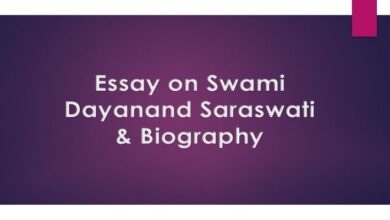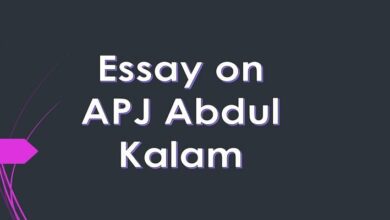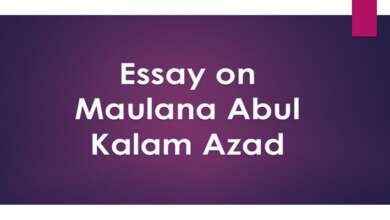Essay on Bhagat Singh in English 1000 Words | PDF
Essay on Bhagat Singh
Essay on Bhagat Singh in English (Download PDF) – Our India’s land has been a land of many heroes. Thousands and millions of people are born and die in this country. They don’t even know their name, but there are some people whose name is not possible to be forgotten. They die and become immortal.
People take their names very respectfully and with reverence. His name only inspires inspiration in life. This is how the name “Shaheed Bhagat Singh” comes in the young men.
If martyr Bhagat Singh wanted, he too could live a life of happiness and comfort. But in the freedom struggle of the country, sacrificed his life laughingly.
He joined the struggle for independence at an early age and was martyred at the young age of 23. The name of this revolutionary Sikh, who suffers in British rule in such a short state, will always remain immortal in the history of the world.
Read also – Essay on APJ Abdul Kalam & Biography
Bhagat Singh’s Birth
Shaheed Bhagat Singh was born on 28 September 1907 in a village called Khatkad Kalan near Jalandhar in Punjab. Bhagat Singh, known for his heroic and revolutionary acts, was born into a family that was actively involved in the struggle for Indian independence.
His father Kishan Singh and younger Uncle Swaran Singh were also counted among the revolutionary leaders of the hot party fighting the freedom struggle.
The number of times the British kept him in jail. The younger Uncle Swaran Singh died due to the inhuman torture in the jail. Born and brought up in a family amidst these freedom fighters, Bhagat Singh got an education in nationalism from there.
Bhagat Singh’s Education
His primary education was completed in his village. In 1916-17, he was admitted to the D.A.V. School in Lahore. His sense of nationalism got a lot of strength here. While reaching the ninth class, he was introduced to revolutionaries like Acharya Jugalkishore, Bhai Parmanand, Shri Jayachandra Vidyalankar.
Along with a college education, he started participating in revolutionary activities. Participated in activities like burning Holi of foreign textiles, opposing the Rowlatt Act.
Read also – Essay on Mother Teresa & Biography
Struggling for Freedom
His blood boiled over the Jallianwala Bagh massacre of 1919. By going the next day he brought the soil soaked with blood from there. With the help of his other colleagues at Lahore National College, he was introduced to Lala Lajpat Rai and some of his prominent leaders Acharya Jugalkishore, and Bhai Parmanand.
Bhagat Singh read a lot about European nationalist movements and was inspired by them in 1925. He founded the Naujawan Bharat Sabha the following year and later joined the Hindustan Republican Association where he came in contact with Sukhdev and Chandrasekhar along with several prominent revolutionaries. He also started contributing to Kirti Kisan Party magazine “Kirti”.
While his parents wanted him to marry around the same time, he turned down their offer, saying that he wanted to dedicate his life to the freedom struggle.
The Turning Point:
In the year 1928, the British Government organized the Simon Commission to discuss autonomy for Indians. It was boycotted by many Indian political organizations as no Indian representatives were involved in the event.
Lala Lajpat Rai took out a procession against him and marched towards Lahore station. In an attempt to control the mob, the police used lathi-charge weapons and brutally killed the protesters.
Lala Lajpat Rai was seriously injured and was hospitalized. He succumbed a few weeks later. Bhagat Singh was angered by this incident and he planned to avenge Rai’s death and killed British police officer John P. Saunders.
He and one of his colleagues later bombed the Central Legislative Assembly in Delhi. After that, Singh confessed his involvement in the incident and surrendered to the police. Meanwhile the trial period, Bhagat Singh went on a hunger strike in jail.
On June 12, 1929, the Sessions Judge granted him life imprisonment under Section 307 on charges of possessing explosives. Meanwhile, the death sentence was fixed. There was no hearing on the appeals made in various courts. The time of execution was fixed in the morning on 24 March 1931.
But on 23 March at 7:33 pm, the British government hung them against the rules a day before. Saying “Mera Rang De Basanti Chola”, the freedom fighter swung on the gallows with Sukhdev and Rajguru. The British government burnt his body on the banks of the Sutlej.
Read also – Essay on Mahatma Gandhi & Biography
Conclusion:
Bhagat Singh was a true patriot. He not only fought for the independence of the country but also did not back down in giving his life in this incident. His death sparked mixed feelings across the country.
Whereas those who followed the Gandhian ideology felt that he was too aggressive and fanatical and that his followers considered him a martyr because he gave his life to hurt the pursuit of freedom. Bhagat Singh is still remembered as Shaheed Bhagat Singh.
Download PDF – Click Here
FAQs. on Bhagat Singh
When was Bhagat Singh born?
Ans. Shaheed Bhagat Singh was born on 28 September 1907 in a village called Khatkad Kalan near Jalandhar in Punjab. Bhagat Singh, known for his heroic and revolutionary acts, was born into a family that was actively involved in the struggle for Indian independence
Why have people different thinking about Bhagat Singh?
Ans. Bhagat Singh was a true patriot and his death sparked mixed feelings across the country. Whereas those who followed the Gandhian ideology felt that he was too aggressive and fanatical and that his followers considered him a martyr because he gave his life to hurt the pursuit of freedom.




